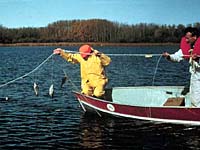

Anglers may catch the limit for each fish species on a single day. At any time, the possession limit is no more than the limit for each species. This limit includes fish eaten that day, given away, at camp, during transporation and at home. Note that, for legal purposes, upper size limit is determined by measuring the total length of the fish with the tail pinched. Some examples of size limits are as follows:
It is illegal to take more fish than the limit specifies (limit includes fish eaten for shore lunch). Fish in cold storage count toward a limit. Frozen fish should be packaged in such a way that they can be counted and identified. A person who stores fish for another must plainly mark the package in ink, with the name, address and fishing licence number of the owner, and the number of fish in the package. Trout ponds have limits; two fish only may be caught, regardless of the species. When large numbers of fish are caught and released, anglers should voluntarily limit their catch. Even with careful handling, delayed mortality of hooked and released fish can be in the order of five percent for walleye and northern pike and ten percent for arctic grayling and trout. To estimate delayed mortality, count one fish killed for every twenty walleye or pike caught or released. For lake trout and grayling, count one fish killed for every ten fish released. This mortality, combined with the number of fish kept, will provide and estimate of total fish kill. You may not take more than the Saskatchewan limit of fish on boundary waters with Alberta, Manitoba, the Northwest Territories and the Prince Albert National Park, unless otherwise specified. Prince Albert National Park is not under the jurisdiction of provincial legislation. Consult Fisheries Canada for more information.
|